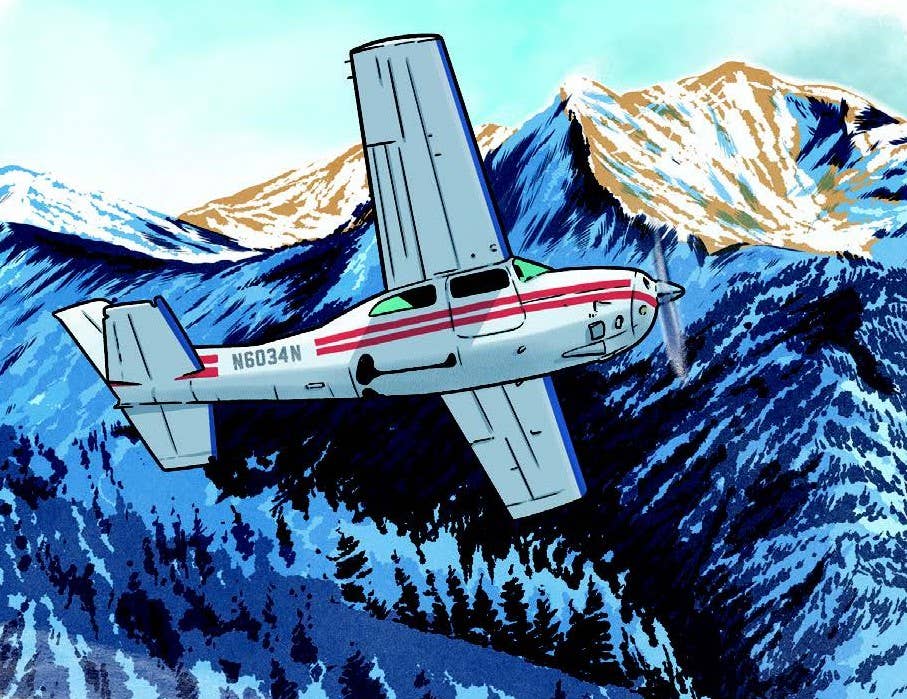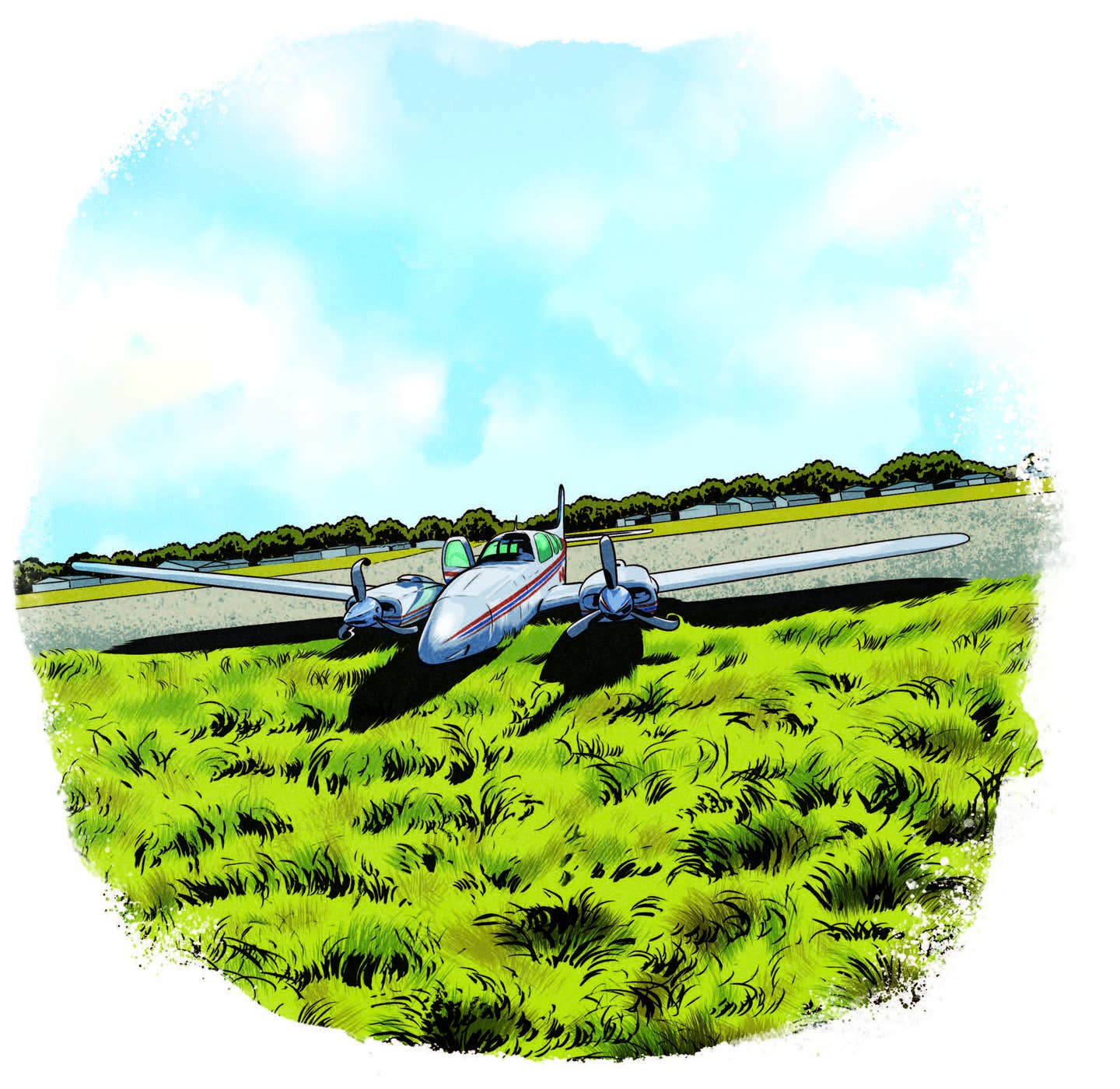Treat High-Altitude Turbulence with Knowledge and Respect
Mountain wave turbulence can be a great teacher that cuts both ways.

If mountain wave turbulence is severe, use both flaps and gear and slow to just above stall speed. [Illustration: Joel Kimmel]
It was October 2006. I had just bought a terrific, well-equipped Cessna T210 about a year before. It had occurred to me that with such a great high-altitude aircraft that I should take some quality mountain flying instruction. A friend had told me of an outstanding mountain instructor based at Vance Brand Airport (KLMO) in Longmont, Colorado, and strongly urged me to take his two-day course.
The first day of the course was basic mountain flying. We covered mountain and high-altitude basics. Where and how to crash-land and survive. How to prepare an emergency pack. How aircraft performed. And so on. It was a thorough and excellent preparation.
If you're not already a subscriber, what are you waiting for? Subscribe today to get the issue as soon as it is released in either Print or Digital formats.
Subscribe NowBy that time in my life, I had hiked and climbed all over central Colorado and felt a bit complacent about all the “stuff” I already knew. In fact, the instructor said he had never had a student as well prepared for emergency survival. (Wow! Thanks.)
The second day we launched from Longmont early in the morning. It was crystal clear and there was minimal wind. We worked our way along the Front Range, turned in toward the mountains just north of Pikes Peak, and then landed at Leadville-Lake County Regional Airport (KLXV), which is the highest airport in North America at 9,934 feet msl. We discussed density altitude, runway length, go-arounds at high altitude, and then landed.
I was alert in taking off from Leadville at almost 10,000 feet, but the turbo did its job, so away we went. We crossed Hagerman Pass (11,925 feet) at 12,500 feet while discussing the need for diagonal crossing of mountain passes in case of severe winds. It was all beautiful.
We worked our way down to the runway at the Glenwood Springs Municipal Airport (KGWS), which is 3,300-feet long at 5,916 feet msl. The instructor made clear that he wanted me at 72 knots, not 73 and not 71, because there was zero excess if I screwed up and landed in a housing development. Fortunately, that went smoothly. We turned around and departed down valley then worked our way up the valley to Aspen-Pitkin County Airport (KASE).
The reputation of Aspen being tricky is well earned. It lies in a narrow valley, but in the T210 it was pretty easy and has been such several times since. After the takeoff from Aspen, we headed to the north on a route that mountain pilots know well—and flatlanders often pay the price for not knowing well.
- READ MORE: Mountain Flying Tips
Heading easterly, we departed back over Hagerman Pass, and then the instructor said he wanted to demonstrate the effects of mountain wave flying. Heading north, we slid to the west side of the valley, and gently the wave pulled at us and we descended. We moved back to the middle of the valley and the descent stopped. We moved to the east up against the range that constitutes the Breckenridge Ski Resort and picked up the rising wave that swept us up and over the slope. It was elegant and beautiful. Then we flew north to return to Longmont.
As we approached Loveland Pass, somewhere around 13,000 feet, a huge, invisible sledgehammer slammed us, causing us to drop at least 1,000 feet. We had completely uncontrolled deviations 90 degrees left and right. Then we fluctuated up and down like a dying whale. I asked the instructor if he had been in s---t like this before. His response was, “Oh, sure…well, not this bad.”
Out of reflex, I dropped a notch of flaps. He admonished me to drop gear, too. Both the wings and fuselage needed to slow so they wouldn’t separate. This continued for what seemed like hours but it was likely minutes. As we slowly settled, we hit a sinker in straight-and-level flight, dropping at more than 1,500 fpm with pegged gauges. Fortunately, that diminished as we closed in on the top of Loveland Pass, which we missed by maybe a few hundred feet.
Unexpectedly, it stopped as it began. I was literally shaking and trembling. Wow. Was I almost killed?
Never before nor since have I experienced such turbulence. But I did come away with several lessons:
Mountain wave turbulence is unpredictable and can be treacherous. Keep plenty of clearance from terrain. Watch for capped clouds, spindrift snow, dust, or terrified pilots.
In particularly moderate to severe turbulence, slow down and drop flaps and landing gear if needed. Even in moderate turbulence and after years of flying, I will drop a notch of flaps to slow down things.
If turbulence is severe, use both flaps and gear and slow to just above stall speed.
Have good restraints and don’t be lazy about keeping them firmly fastened. Even with good restraints, we slammed our heads several times.
Mountain wave turbulence can be a great teacher that cuts both ways. Understand and respect it.
Subsequently, I have experienced many turbulent flights in the T210 and other aircraft. Admittedly, I had PTSD for several years after that episode, but you’ve got to get back on the horse and ride.
This is submitted in memory and honor of my friend and instructor, Cleon Biter, from Longmont. Cleon was an outstanding, patient, and brave flight instructor who died from nonaviation causes after surviving years of flying with young mountain pilots.
This column first appeared in the October 2023/Issue 942 of FLYING’s print edition.

Sign-up for newsletters & special offers!
Get the latest FLYING stories & special offers delivered directly to your inbox







